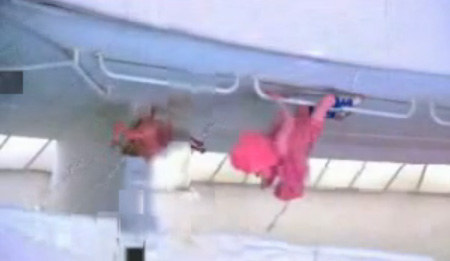
Above is a still from Paul B. Davis's Compression Study #4 (Barney) /short version [YouTube]. Although the Matthew Barney video it's based on is Art that sells for the big bucks at Barbara Gladstone gallery it somehow ended up in smaller form on YouTube, and that's Davis's actual source. I saw Barney's show at the Guggenheim and may have seen snatches of the video of his wall-climbing performance there but I now mainly know the event through this YouTube, which I've watched more times. Davis's process (called "Data Moshing" by some and also seen in some recent pop music videos, although Davis did it before they did) adds some much-needed ambiguity to the Cremaster series' rather literal, theatrical surrealism. Data moshing is all about strange, temporal shifts and it's creepy, for example, to watch a cat-creature emerge suddenly out of a cloud of frozen Barney-pixels in the Davis version. As with the analog-scrambled porn channels one might have encountered surfing around the TV dial in the 80s and 90s, you tend to look more closely at what you think is there. The imagination can supply prurience or horror but Barney is the type of artist who likes to do all the imagining for you.
On the art-pop-culture-art loop front there are curious echoes between the Davis piece and a painting from a decade ago by Michael Bevilacqua, also dealing with Barney. This had a real transgressive frisson at the time, and rumor has it Barney was annoyed by these paintings (and, I suspect, the fact that Bevilacqua was selling them out).

Here's what David Ebony said about that work in his Top Ten for artnet, 1997:
Perhaps the most astonishing works in the show are those based on scenes from Matthew Barney's 1994-95 film, Cremaster 4. The large painting Dig Your Own Hole shows Barney's so-called Faeries, in orange wigs and blue jumpsuits, carving a large hole on a pier, an early scene in the film. The upper left portion of the canvas is tightly packed with fragments of corporate logos, as well as a logo for the band Oasis. In these brilliant canvases it seems as if Bevilacqua has succeeded in creating a bit of instant art history. By transforming such a recent work as Cremaster 4 into a pop icon, Bevilacqua reminds viewers of, among other things, the speed at which culture can be assimilated.
This was in the super-slow world of painting and gallery practice, and now we're talking about the same things happening in seconds online.
